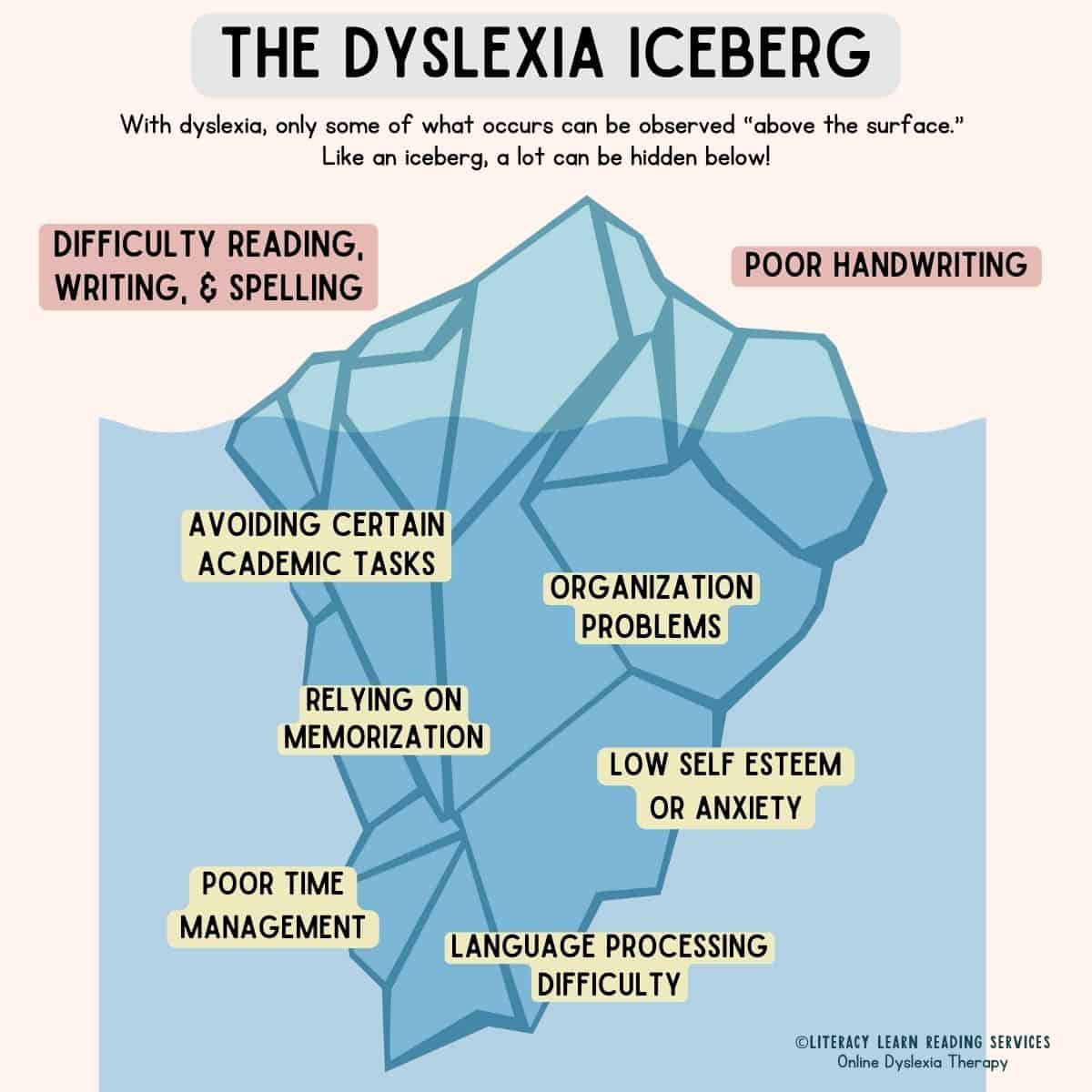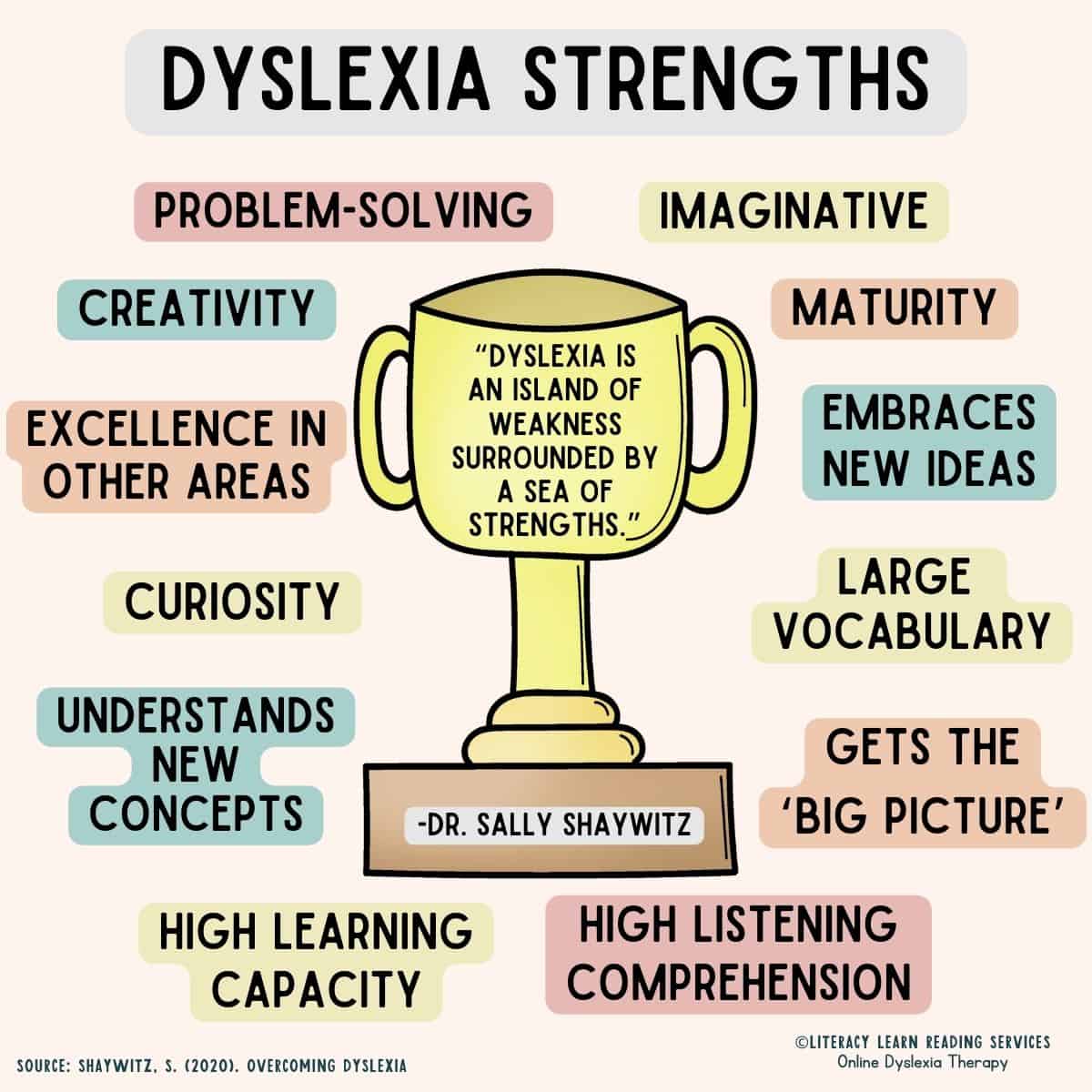Hidden Dyslexia Symptoms: The Dyslexia Iceberg
This post may contain affiliate links. As an Amazon affiliate, we earn from qualifying purchases.
What are the symptoms of dyslexia? Like an iceberg, some symptoms are visible, while much is hidden. Learn about the hidden and visible symptoms of dyslexia, the strengths of dyslexia, and how to support kids!

This post is sponsored by Lexercise. All opinions are our own!
📚 Take a free Dyslexia Screener and learn more about Dyslexia Therapy options for struggling readers and writers!
Symptoms of Dyslexia
Although most of us have some familiarity with dyslexia, you might not realize that it can be very tough to spot. That’s because many of the signs and symptoms of dyslexia are, by their nature, difficult to observe.
The Dyslexia Iceberg describes how some symptoms of dyslexia are easy to see, while others are more hidden.
Parents and teachers tend only to notice the most visible signs. These “above the surface” symptoms— like trouble with reading, writing, and spelling— are different for each child since dyslexia occurs on a continuum.
But often there’s a lot more happening beneath the surface. These are the deeper, less obvious challenges than the ones we can easily observe. Issues with sound processing, which we can’t see, can be ongoing.
And that can lead to more struggles with daily frustration, avoidance, anxiety, and low self-confidence, among other things! This is referred to as the “Vortex of Dyslexia.”
Observable Symptoms of Dyslexia Can Include:
- Problems with reading, writing, and spelling
- Skipping words or lines when reading
- Poor handwriting
- Difficulty reading words out of context
- Slow, disfluent reading
- Difficulty with phonological awareness and phonemic awareness tasks
Hidden Symptoms of Dyslexia Can Include:
- Slow or weak processing problems
- Poor concentration
- Organization problems
- Difficulty following instructions
- Difficulty with sequencing
- Relying on memorization rather than understanding
- Avoidance of certain reading or academic tasks
- Poor time management skills
- Easily distracted
- Low self-esteem, anxiety, or depression
So how do we know what’s really going on? How can we know if a child’s struggles are related to a deeper issue like dyslexia?
Many people revert to the “let’s wait and see” approach, but that is not the answer. Identification and intervention are essential and cannot wait.
The International Dyslexia Association (IDA) says screening tests should be done with all children in a school, beginning in kindergarten, to locate those students who are at risk for a reading difficulty.
If you have immediate concerns, you can take a dyslexia screener today and then get your child a reading and spelling inventory to evaluate their strengths and weaknesses.
Then, the IDA asserts that “[p]reventative intervention should begin immediately, even if dyslexia is suspected.” The appropriate intervention is structured literacy.
The IDA says that most reading difficulties can be reduced or diminished with structured literacy from highly knowledgeable and skilled teachers. Look for more info from us soon, talking about structured literacy and how it helps kids!
The next step depends on how the child responds to intervention. If there are further concerns, a full language processing evaluation can be done to assess the under-the-surface problems.

Strengths of Dyslexia
“Dyslexia is an island of weakness surrounded by a sea of strengths.” -Dr. Sally Shaywitz
It’s important to both recognize and nurture the positive abilities of people with dyslexia. So if you suspect dyslexia in your child, you should look for their strengths, not just deficits.
Dyslexia Strengths May Include:
- Curiosity & creativity
- Understanding new concepts
- Large listening vocabulary
- Embracing new ideas
- Problem-solving
- High listening comprehension
- Excellence in areas that don’t rely on reading
- High learning capacity
- Imaginative
- Mature
It is a myth that dyslexia is related to intelligence. People of all intellectual abilities have difficulty with reading, writing, and spelling, and they are often creative, gifted, and successful.
In some ways, the unique strengths and positive characteristics associated with dyslexia are actually advantages!
How to Support Kids
Dyslexia affects about 1 in every 5 people. If we can better understand dyslexia, it will help us better support and advocate for our kids and students.
This is why early screeners, assessments, interventions, and structured literacy instruction are critical!
👉 Parents: If you have a child who’s struggling with reading and writing, please don’t wait. The first step is to get help. It’s a tricky process, and we’re here to help you navigate it.
- Your child can take a free dyslexia screener. It’s a great starting point because the test is designed to assess both the observable and the hidden symptoms. It can indicate whether a child is at risk for dyslexia and may need further evaluation.
- Your child can complete a reading and spelling inventory. This details your child’s strengths and weaknesses in reading, writing, and spelling, and is followed by an online, face-to-face meeting with an expert therapist.
- Schedule a free consultation with one of Lexercise’s structured literacy experts!
Public schools are full of amazing, well-meaning educators, but the challenges persist, leaving our kids without the help they deserve.
Just this week, I attended a meeting I requested for my son, who’s already been diagnosed with a learning disability. Despite my knowledge and experience with these meetings, I couldn’t cut through the bureaucratic red tape to get him the additional support he needs now. Instead, we’re stuck waiting for yet another meeting.
👉 Curious why this happens? Check out why public schools struggle with dyslexia support, and take a look at this flowchart to see why the process can be so slow and difficult.
We also recommend the book Dyslexia Advocate: How to Advocate for a Child with Dyslexia Within the Public School System to parents who need help. It’s an invaluable source for any concerned parent trying to navigate the complicated public school system.
👉 Teachers: If you’re looking to learn more, visit Lexercise’s Professional Development courses. We’ve personally taken them and learned SO much. Katie is a Course 3 practicum graduate; read about her experience getting OG certified!
If you don’t have time to do this IDA Accredited Plus course series, and want to start helping your students immediately, check out Lexercise’s school-based structured literacy curriculum.

Be sure to check out the other installments of this informational series:
- What is Dyslexia? Characteristics, Definitions, Resources, and More.
- Debunking Common Dyslexia Myths
- How Structured Literacy Helps Struggling Readers & Writers
We hope this information has been helpful to you! If you have any questions or concerns, please leave a comment below!!
Sources:
- Is My Child Dyslexic? Signs of Dyslexia by Age Dyslexia British Dyslexia Association
- Dyslexia Basics International Dyslexia Association
- Testing & Evaluation International Dyslexia Association

